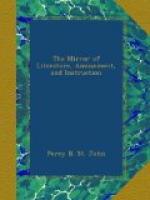The “Confessio Amantis” was printed, a second time, by Barthelet, in the year 1532; a third time in 1544; a fourth in 1554; and, lastly, in a very correct and worthy manner, in the year 1810, under the judicious inspection of Dr. Chalmers.
It were ungrateful to withhold from Gower some acknowledgment of the share he had in producing a beneficial revolution in the English language; as it would be absurd and untrue to attribute to him any great degree of praise, as an inventor in that important work.
* * * * *
The church of St. Saviour was founded before the conquest, but was principally rebuilt in the fourteenth century, since which time it has undergone many extensive reparations at different periods. The tower, which is surmounted by four pinnacles, was repaired in 1818 and 1819; and the choir has been recently restored in conformity with the original design, under the superintendence of that indefatigable architect, Mr. George Gwilt.[2] The dramatists, Fletcher and Massinger were buried in this church in one grave; and from the tower, Hollar drew his Views of London, both before and after the fire.
[2] Only the tower and the choir have yet been restored; but the fidelity with which these portions have been executed, heightens our anxiety for the renovation of the whole structure. The repairs of the south transept will, we believe, be shortly commenced, but the fate of the nave and aisles is not yet decided. These are in a dilapidated condition.
Mr. Gwilt has already expended much time and research into the history of this very interesting structure. On our last week-day visit to the church, we saw the fine arch of a Saxon door just uncovered after a concealment of many ages, in one of the surveys of this erudite artist, who is sedulously attached to the study of antiquities, and is an honour to his profession. We ought not to forget the altar-screen which has lately been restored under Mr. Gwilt’s superintendence. Indeed, the inspection of this venerable fabric will repay a walk from the most remote corner of the metropolis.
Besides the tomb of Gower, there are monuments to Launcelot Andrews, Bishop of Winchester; Richard Humble, Alderman of London, erected in 1616; and several others. Gower’s monument was once very splendid, but its present state is not very indicative of the gratitude of the parish in which he perpetuated his munificence by erecting one of the finest churches in the metropolis.
* * * * *
In 1737, so slight and infrequent was the intercourse betwixt London and Edinburgh, that men still alive (1818) remember that upon one occasion the mail from the former city arrived at the General Post-Office in Scotland, with only one letter in it—Scott’s Novels.
* * * * *




